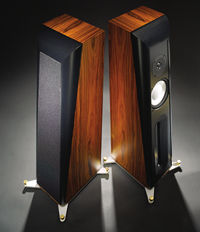| Columns Retired Columns & Blogs |
Thiel CS1.6 loudspeaker
In the past year, Stereophile has reviewed a number of cost-no-object flagship loudspeakers. B&W's Signature 800, MartinLogan's Prodigy, Burmester's B-99, Snell's XA Reference Tower, Krell's LAT-1, Linn's Komri, Dynaudio's Evidence Temptation, Sony's ES SS-M9ED, and Rockport's Antares have all passed through the review mill. Manufacturers like to submit their flagships for review for a number of reasons, not the least of which is the pride they take in showing what their engineers can do when given a blank check. However, while all these models do indeed provide great (if different) sound for the tens of thousands of dollars they demand from their owners, they are out of reach of the majority of audiophiles. It is important, therefore, for reviewers to spend time with real-world designs; when I heard the $1990/pair CS1.6 from Kentucky's Thiel at the 2002 CES last January, I requested a pair for review.
 A Coherent Source
A Coherent Source
The CS1.6 is the successor to Thiel's CS1.5, a denizen of this magazine's "Recommended Components" listing ever since Sam Tellig enthused over it in August 1994. (He also wrote about it in May '96, while Muse Kastanovich's November '95 review included a full set of measurements.) Like the '1.5, the '1.6 is a floorstanding two-way design with a sloped-back front baffle. That's where the resemblance ends, however, as every other aspect of the 2002 speaker's design is new.
Whereas the CS1.5's baffle was flat, with step-backs for the hefty grille, the '1.6's is elegantly sculpted with a CNC machine to optimize dispersion, the minimal grille fitting into a shallow depression and held with concealed magnets. With the grille removed, the most obvious visible feature is a long vertical slot beneath the woofer, surrounded by a machined flare. This slot acts as the reflex port, but its geometry is claimed to minimize wind noise and any modification of its tuning by the grille.
The 6.5" woofer, designed and manufactured in-house, uses a 3" voice-coil to drive the metal cone closer to its perimeter than usual. This is said to increase the stiffness of the cone, pushing the inevitable breakup modes much higher in frequency than with a conventional cone and voice-coil. The large coil allows the neodymium magnet to be housed completely within the voice-coil former, inherently shielding the magnet. The 1" tweeter uses a metal dome and, like the woofer, features a short coil with a copper distortion-reducing ring, operating in a long gap. The tweeter dome is recessed slightly in a front plate with a short flare, which will increase its on-axis sensitivity to match the efficient woofer, at the expense of restricting the unit's dispersion in the top octave.
The crossover is, as is usual in Thiel's Coherent Source designs, a phase-optimal first-order type. This and the sloping back baffle allow the sounds from both drivers to arrive at the listener's ears at the same time. In a welcome departure from earlier Thiel speakers, the CS1.6's sturdy terminal posts are sited on the rear of its cabinet rather than the base.
Sound
Setting up the CS1.6s involved finding positions for them that gave the optimum balance among four nonrelated aspects of sound quality. The speaker's bass region is intrinsically shelved-down. However, moving the speakers close to the sidewalls to give some boundary reinforcement of the low frequencies also emphasized some residual hardness in the low treble, and resulted in a balance that was too bright with the speakers facing straight ahead. Moving the speakers well away from the sidewalls gave a sound that was clean and clear, but with insufficient bass. Keeping the speakers where they had the most extended bass but toeing them in so that they faced the listening seat reduced the hardness, added some useful top-octave air, and gave a soundstage that was superbly detailed and stable. On the downside, the overall sound was still a little bright for my tastes and system.
Ultimately, I moved each speaker forward along the line joining its acoustic center to the listening position, noting how the drop in bass weight was balanced by a corresponding drop in low-treble hardness. This sounds more straightforward than it was because the CS1.6's overall sound changed more during the break-in process than I am used to. Thiel recommends 50 hours "at moderately loud levels," but at the end of the month during which I used the Thiels for my everyday listening, I was still not sure that they'd reached equilibrium.
But what had begun as brightness had been transformed into superb resolution of detail. What had started out as a lightweight, not too well-defined low-frequency register ended up as a balance that worked well on such superb double-bass recordings as Edgar Meyer's new disc of concertos, by himself and Bottesini, with the St. Paul Chamber Orchestra (Sony Classical SK 60956). Meyer's Concerto in D starts with some E-string grumbling and portamento slides, all rendered perfectly clearly on the CS1.6s, without any boom obscuring the instrument's pitch.
- Log in or register to post comments




































